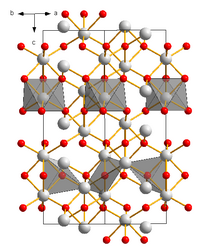Vanadium(III) oxide
 |
|
| Names | |
|---|---|
| Other names
Vanadium sesquioxide, Vanadic oxide
|
|
| Identifiers | |
| ECHA InfoCard | 100.013.847 |
|
PubChem CID
|
|
| RTECS number | YW3050000 |
| Properties | |
| V2O3 | |
| Molar mass | 149.881 g/mol |
| Appearance | Black powder |
| Density | 4.87 g/cm3 |
| Melting point | 1,940 °C (3,520 °F; 2,210 K) |
| Solubility in other solvents | Insoluble |
| +1976.0·10−6 cm3/mol | |
| Structure | |
| Trigonal (karelianite), hR30 | |
| R-3c h, No. 167 | |
| Thermochemistry | |
|
Std molar
entropy (S |
98.07 J/mol·K |
|
Std enthalpy of
formation (ΔfH |
-121.8800 kJ/mol |
|
Gibbs free energy (ΔfG˚)
|
-113.9052 kJ/mol |
|
Except where otherwise noted, data are given for materials in their standard state (at 25 °C [77 °F], 100 kPa).
|
|
|
|
|
| Infobox references | |
Vanadium(III) oxide is the inorganic compound with the formula V2O3. It is a black solid prepared by reduction of V2O5 with hydrogen or carbon monoxide.It is a basic oxide dissolving in acids to give solutions of vanadium(III) complexes. V2O3 has the corundum structure. It is antiferromagnetic with a critical temperature of 160 K. At this temperature there is an abrupt change in conductivity from metallic to insulating.
Upon exposure to air it gradually converts into indigo-blue V2O4.
In nature it occurs as the rare mineral karelianite.
...
Wikipedia
